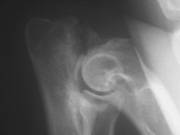
Photo by Dr. Greg Harasen
Elbow dysplasia is the most common cause of lameness on a front leg in young dogs, especially of the larger breeds.
Dysplasia refers to abnormal development, in this case of the elbow joint.
The elbow is formed from where three bones meet: the humerus, which is the upper limb from shoulder to elbow; the ulna, from the elbow to the paw along the back of the limb; and the radius, which supports the major weight-bearing along the front of the lower limb. All three of these bones need to grow and develop normally and at the same rate such that they fit perfectly together. If there are any abnormalities along these lines, or if the cartilage lining the elbow joint does not form properly, then dysplasia or an abnormal formation results.
Elbow dysplasia can take several different forms. They can be seen individually or combined.
While all of the variations are distinct and probably develop in different ways, they all produce loose pieces of bone and/or cartilage within the joint that act as irritants, much as a pebble does in your shoe. These variations also are primary problems that invariably lead to arthritis in the elbow. The term arthritis simply describes inflammation within a joint. The longer time an elbow joint is ill-fitting or irregular, the more arthritis forms.
While traumatic episodes may affect the elbow's development, the vast majority of elbow dysplasia cases are genetic in origin.
Symptoms
The first sign of a problem is a mild to moderate front leg lameness in a young dog between 4 to 10 months. If the problem is not diagnosed at this stage, more lameness may be seen as severe arthritis sets in. In the following list of commonly affected breeds, it’s mostly large breed dogs that suffer from elbow dysplasia.
- Bearded Collie
- Bernese Mountain Dog
- Chow Chow
- German Shepherd
- Golden Retriever
- Labrador Retriever
- Newfoundland
- Rottweiler
- St. Bernard
- Bassett Hound
Diagnosis
The history of front leg lameness in a young, large breed dog is suggestive of elbow dysplasia. When examined, the elbow may show pain, thickening or swelling, and restricted movement. Radiographs of the elbow will usually confirm the diagnosis. There are usually radiographic signs that suggest the diagnosis. Advanced imaging studies, particularly computed tomography (CT scan), may be helpful. Ultimately, surgery may be needed to provide a complete diagnosis. In recent years, such exploration is most often done with an arthroscope, a camera that is inserted in the joint without the need of major open surgery.
Treatment
The use of an arthroscope provides the preferred means of diagnosis and treatment for many cases of elbow dysplasia. Some cases may be managed with open joint surgery and still others may do well with medications alone, such as anti-inflammatories. Early surgical management of these problems provides the best chance for minimizing arthritic changes in these elbows, but virtually all dysplastic elbows will develop some degree of arthritis. Older dogs, where arthritis is well established, may still benefit to some degree from arthroscopic surgery but the benefits are less predictable. The newest generation of canine anti-inflammatory drugs, along with supplements and diets high in omega-3 fatty acids, may provide some relief.